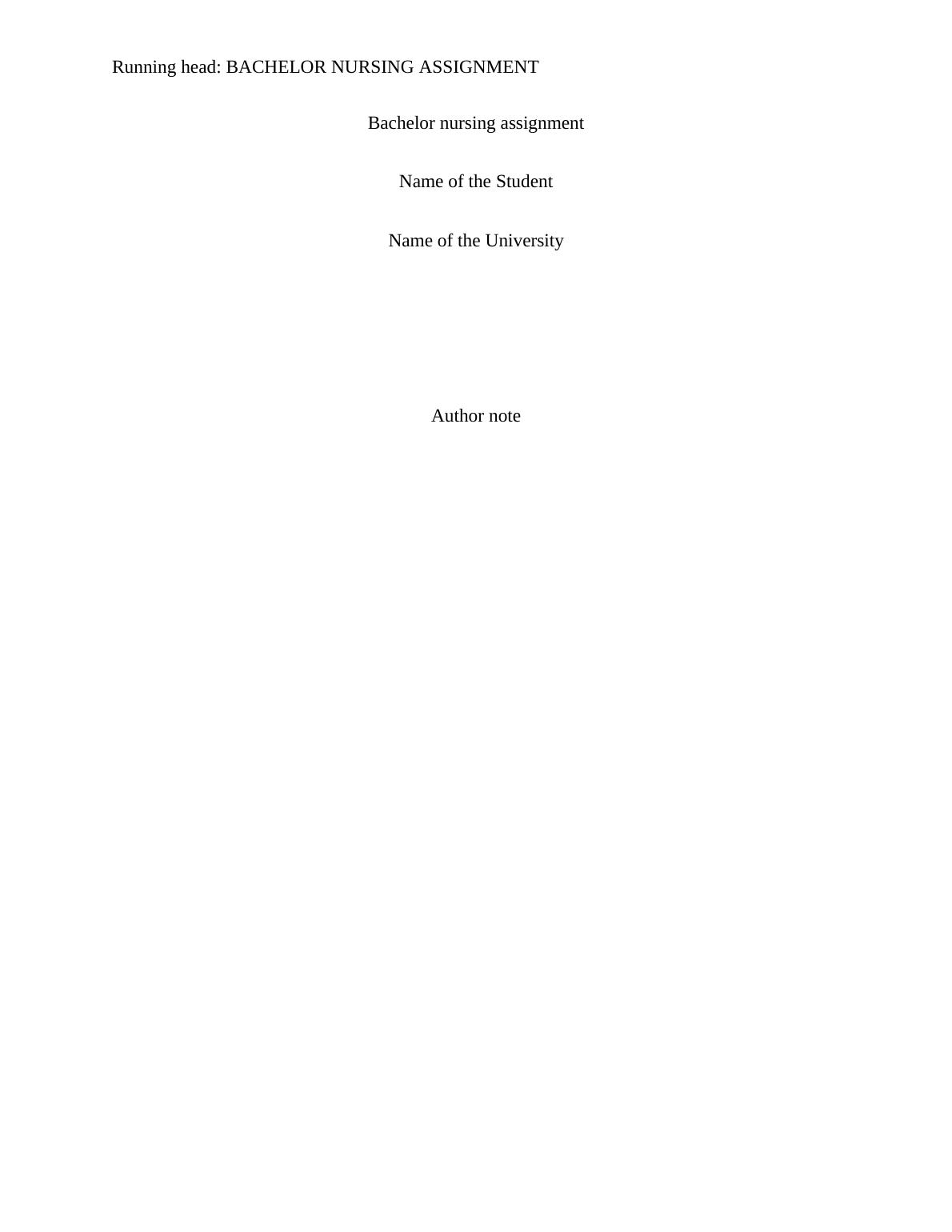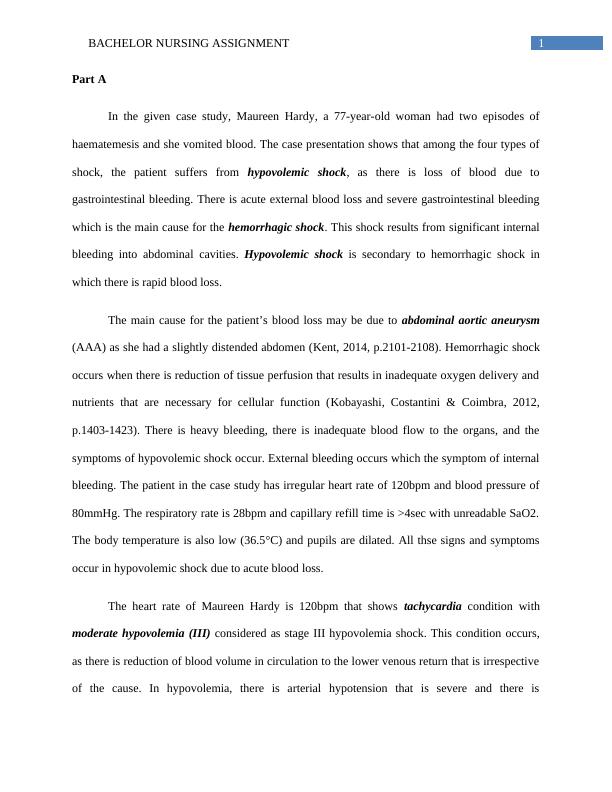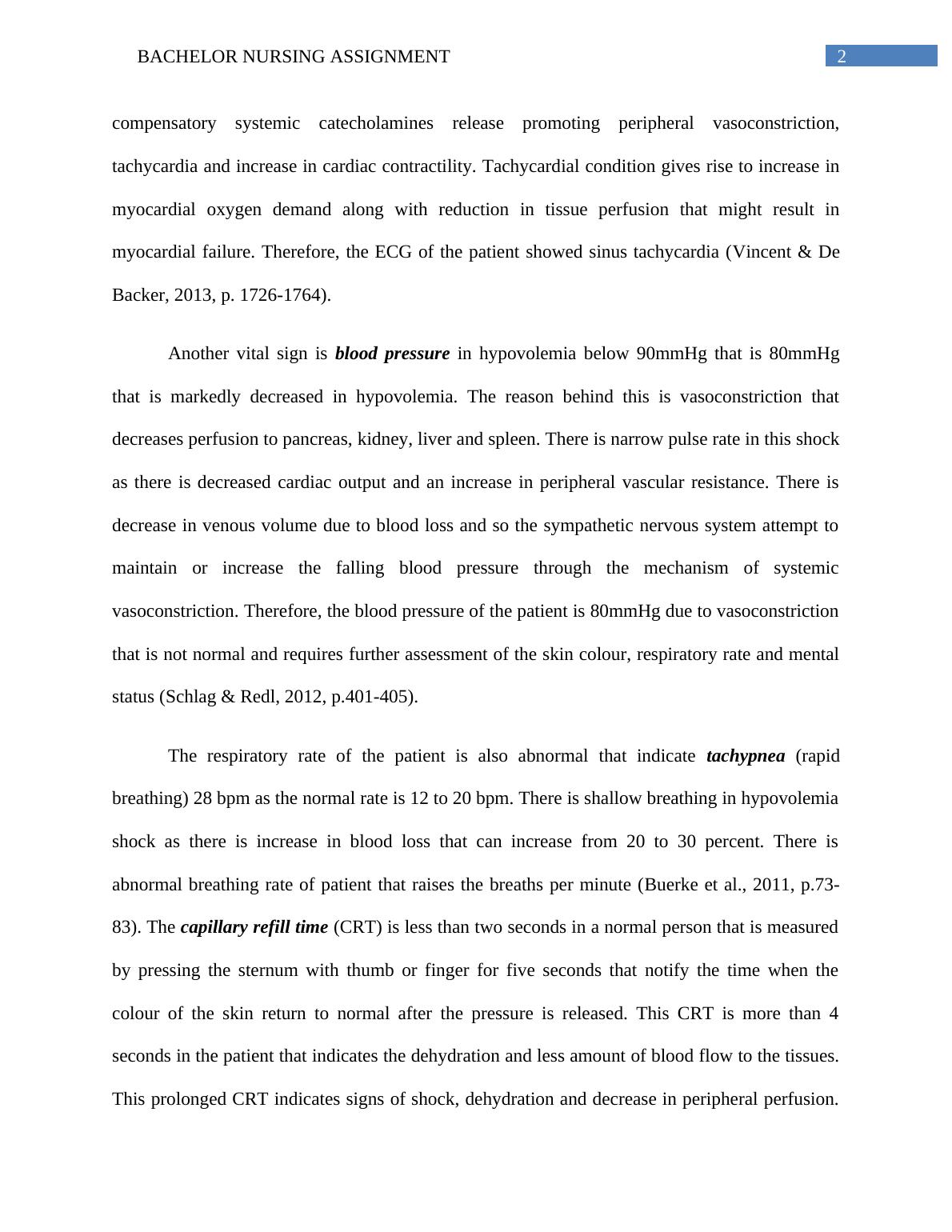BACHELOR NURSING ASSIGNMENT.
Added on 2019-10-30
10 Pages2367 Words294 Views
Running head: BACHELOR NURSING ASSIGNMENTBachelor nursing assignmentName of the StudentName of the UniversityAuthor note

1BACHELOR NURSING ASSIGNMENTPart AIn the given case study, Maureen Hardy, a 77-year-old woman had two episodes ofhaematemesis and she vomited blood. The case presentation shows that among the four types ofshock, the patient suffers from hypovolemic shock, as there is loss of blood due togastrointestinal bleeding. There is acute external blood loss and severe gastrointestinal bleedingwhich is the main cause for the hemorrhagic shock. This shock results from significant internalbleeding into abdominal cavities. Hypovolemic shock is secondary to hemorrhagic shock inwhich there is rapid blood loss. The main cause for the patient’s blood loss may be due to abdominal aortic aneurysm(AAA) as she had a slightly distended abdomen (Kent, 2014, p.2101-2108). Hemorrhagic shockoccurs when there is reduction of tissue perfusion that results in inadequate oxygen delivery andnutrients that are necessary for cellular function (Kobayashi, Costantini & Coimbra, 2012,p.1403-1423). There is heavy bleeding, there is inadequate blood flow to the organs, and thesymptoms of hypovolemic shock occur. External bleeding occurs which the symptom of internalbleeding. The patient in the case study has irregular heart rate of 120bpm and blood pressure of80mmHg. The respiratory rate is 28bpm and capillary refill time is >4sec with unreadable SaO2.The body temperature is also low (36.5°C) and pupils are dilated. All thse signs and symptomsoccur in hypovolemic shock due to acute blood loss. The heart rate of Maureen Hardy is 120bpm that shows tachycardia condition withmoderate hypovolemia (III) considered as stage III hypovolemia shock. This condition occurs,as there is reduction of blood volume in circulation to the lower venous return that is irrespectiveof the cause. In hypovolemia, there is arterial hypotension that is severe and there is

2BACHELOR NURSING ASSIGNMENTcompensatory systemic catecholamines release promoting peripheral vasoconstriction,tachycardia and increase in cardiac contractility. Tachycardial condition gives rise to increase inmyocardial oxygen demand along with reduction in tissue perfusion that might result inmyocardial failure. Therefore, the ECG of the patient showed sinus tachycardia (Vincent & DeBacker, 2013, p. 1726-1764). Another vital sign is blood pressure in hypovolemia below 90mmHg that is 80mmHgthat is markedly decreased in hypovolemia. The reason behind this is vasoconstriction thatdecreases perfusion to pancreas, kidney, liver and spleen. There is narrow pulse rate in this shockas there is decreased cardiac output and an increase in peripheral vascular resistance. There isdecrease in venous volume due to blood loss and so the sympathetic nervous system attempt tomaintain or increase the falling blood pressure through the mechanism of systemicvasoconstriction. Therefore, the blood pressure of the patient is 80mmHg due to vasoconstrictionthat is not normal and requires further assessment of the skin colour, respiratory rate and mentalstatus (Schlag & Redl, 2012, p.401-405). The respiratory rate of the patient is also abnormal that indicate tachypnea (rapidbreathing) 28 bpm as the normal rate is 12 to 20 bpm. There is shallow breathing in hypovolemiashock as there is increase in blood loss that can increase from 20 to 30 percent. There isabnormal breathing rate of patient that raises the breaths per minute (Buerke et al., 2011, p.73-83). The capillary refill time (CRT) is less than two seconds in a normal person that is measuredby pressing the sternum with thumb or finger for five seconds that notify the time when thecolour of the skin return to normal after the pressure is released. This CRT is more than 4seconds in the patient that indicates the dehydration and less amount of blood flow to the tissues.This prolonged CRT indicates signs of shock, dehydration and decrease in peripheral perfusion.

End of preview
Want to access all the pages? Upload your documents or become a member.
Related Documents
Pathophysiology and Nursing Goals for Post-Operative Hypovolemia in Acute Carelg...
|13
|3245
|101
Pathophysiology of Post-Operative Hypovolemialg...
|14
|2794
|373
Nursing Care Of Hypovolemic Care Case Study 2022lg...
|14
|3714
|21
Nursing Assignment: Hypovolemic Shock and Nursing Interventionslg...
|11
|2593
|238
Nursing: Anticipating Clinical Deterioration Signs in Patientslg...
|13
|3070
|340
Nursing | Pathophysiology of Pulmonary Embolismlg...
|7
|1527
|27
